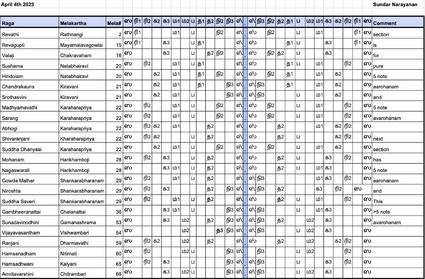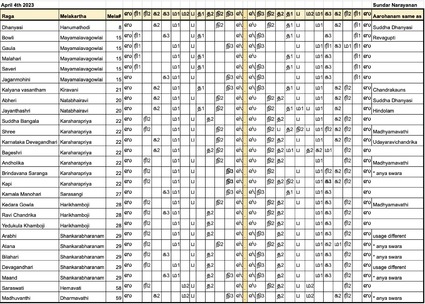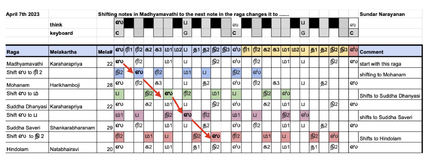When the rug gets pulled under your feet...
 Wednesday, May 31, 2023 at 7:24AM
Wednesday, May 31, 2023 at 7:24AM The recent spring concerts I attended were not just a treat to the ears, but also a treasure trove when it came to learning new things.
Not just talking about the new ragams that we got to hear and appreciate and add to our list of things to cross correlate for future raga identification, but the specific details and comments made by the singers during the concert.
Two of these concerts had the same nugget of information presented in slightly different ways. When Sudha Raghunathan started explaining the concept of "graha bedam" (planetary shifts would be my literal translation or place changes a more amenable translation?) I was simply lost.
She started explaining it this way. We start with Madhyamavathi ragam and if we move the base Sa (imagine C in a C to C scale) to the next note in the raga, and we prounce the notes differently keeping the original frequencies, we end up with a new known raga. This type of note shifting on the same original scale gives you five ragas.. when you start with a five note raga like Madhyamavathi.. she asked the audience what happens when you make the "ri" into the "sa" and what happens when you make the "ga" into the "sa" and some audience members responded.. and as she kept asking the volume and number of answers dropped exponentially. It was funny to watch. For me, it was like my ground shifted!
Sitting there trying to grapple with what was happening, my head started hurting. I am a drawing board kind of guy who is a very visual learner. Made a mental note of this and came home and searched google for pictorial explanations of this. Did not find anything that clearly showed me this.. so made a chart to explain this.
Before doing that though, wanted to make a list of five note ragas using the same style to try and pick from the raga list. There was a lot of time spent double checking this across multiple sites. In spite of that, there are possible mistakes in this. Some ragams have complex multiple descending sequences and that might not be same across sites. Some ragams are essentially the same notes, but the way the notes are used in select sequences to bring out the flavor of the raga (think catch phrases.. or literally "pakkad" in Hindustani terms) is just different.
First a list of pure five note ragas that are common and where at least two songs are there to identify it. This one has the ascending scales listed and descending scales listed
Then there were ragas that had five notes in aarohanam (ascending sequence) but more than five notes inavarohanam (descending sequence). Made a table of that as well.. which came in handy after another concert!
Once this list was done, I did not even have to know what raga turned into what. Just go on a sequence of Sa to Sa to the next octave Sa. Type in the first ragam, see what the notes changed to, cross refernce with the first table.. and voila.. it was easy to see what she was talking about!
You can click on the images to get a large size version.
The idea is this, based on my limited understanding. If you start with Madhyamavathi, you make the "ri" the "sa" and move all corresponding notes in Madhyamavathi raga relatively on a keyboard (shift it by same number of keys), then you get the next ragam. It is the sound you make versus the syllable you say but the way this is done in a concert is simply masterful. You need total command over the placement of the notes in their respective frequencies to the point where saying something different consistently and shifting it and doing it all over again makes it sound natural.
To a layman, it sounds like magic. I felt like that monkey in the youtube videos that is amazed by a magic trick! Only after doing all this notation, there was some understanding and an "aa-haa!" moment. Some folks have the natural ability to visualize this and it is easy for them as they are steeped in music. For other learners who need music aids, this might hopefully help!
Again, mistakes if any are mine. So advance apologies for them. If you read this and find ways to correct this, please drop a note.
This same concept was done at a more advanced level by RaGa (Ranjani Gayathri sisters) in their Raaja by RaGa concert. They started with one raga and went to explore both five and six note ragas with this same shifting and covered it with songs composed by Ilayaraja in movies. It was done brilliantly. With each shift they covered a five and six note raga variation.
There were many amazing nuggets of information and learnings across all concerts. Will share them over the next few weeks.
Until then, the learning continues..
 Carnatic,
Carnatic,  five notes,
five notes,  graha bedam,
graha bedam,  graha bedham,
graha bedham,  learning,
learning,  music,
music,  note shift,
note shift,  pentatonic scale in
pentatonic scale in  carnatic,
carnatic,  concert,
concert,  learning,
learning,  music,
music,  note shifting
note shifting 



